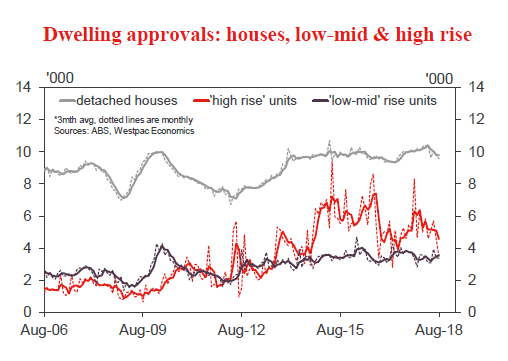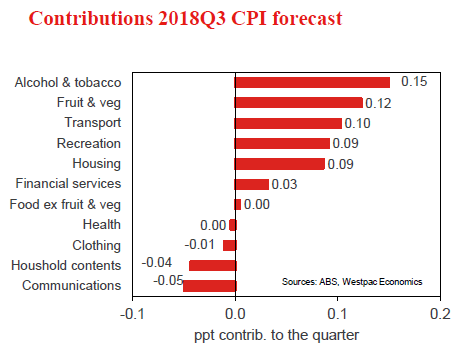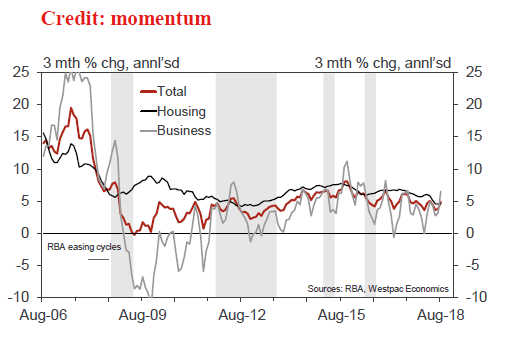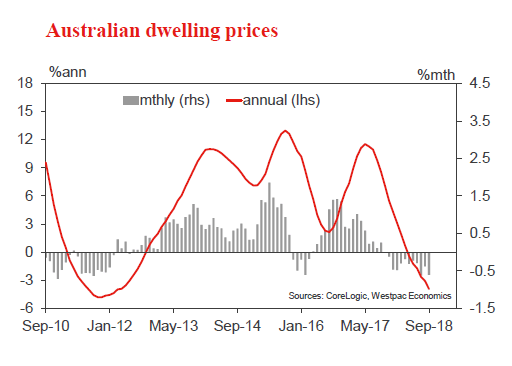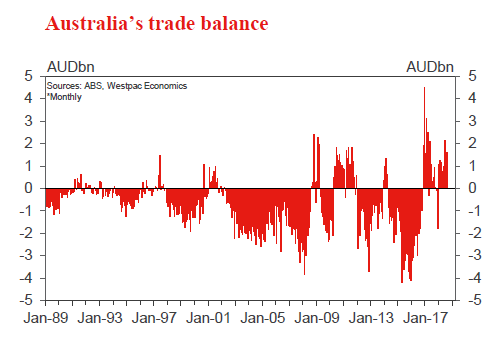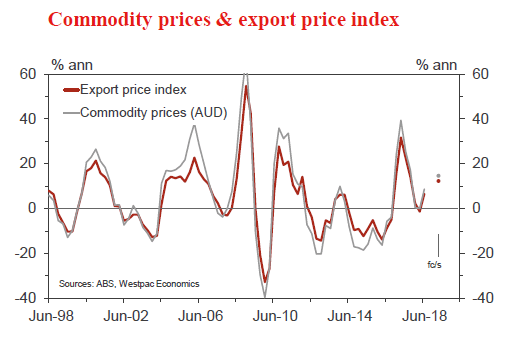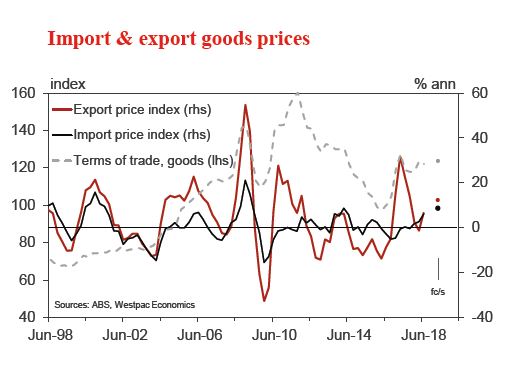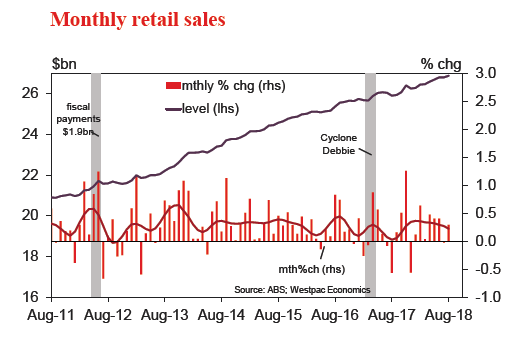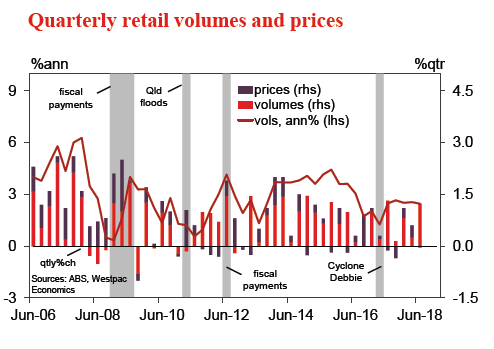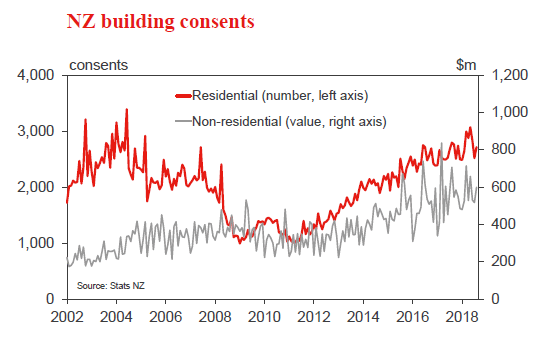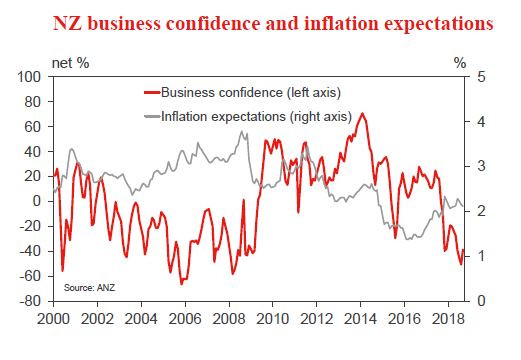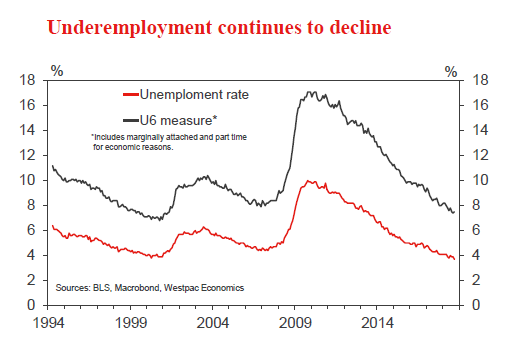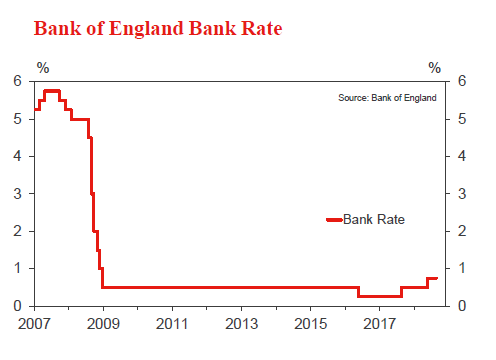Week beginning 29 October 2018
- Looking through monthly volatility, Westpac’s employment outlook for Australia
- RBA: Assistant Governor Bullock speaks.
- Australia: CPI, retail trade, import/export prices, trade balance, dwelling approvals.
- NZ: residential building consents, business confidence.
- China: NBS PMI’s.
- Europe: GDP, employment, CPI.
- US: PCE inflation, Treasury refunding announcement, ECI, nonfarm payrolls.
- Other central banks: BoE policy decision, BOJ policy decision.
- Key economic & financial forecasts.
Information contained in this report current as at 26 October 2018.
Looking through Monthly Volatility, Westpac’s Employment Outlook for Aus
Household and business surveys guide the near term
When forecasting the near term pace of employment growth we use the labour market indicators from the household and business sentiment surveys.
From the Westpac-Melbourne Institute Consumer Sentiment Survey there is the question on household unemployment expectations (do they expect unemployment to rise or fall?) which has a good fit with the momentum in the labour market.
Unemployment expectations have risen modestly (households expect unemployment to rise a little thus a softening in the labour market) but still holding at a historically robust level. However, employment overshot unemployment expectations through the second half of 2017 so an undershoot through to the mid 2019 would be a normal course of events.
The multiple business surveys in Australia have questions that are applicable to the labour market. To generate a broad, deep labour market indicator, Westpac compiles all the relevant indicators from these surveys into the proprietary Westpac Jobs Index from which we generate a predicted pace for annual employment growth. It is true that the Jobs Index is more stable than the annual pace of employment growth but we have found it provides a useful guide on both the near term pace of employment growth and, more importantly, major turning points.
Currently the Jobs Index is pointing to employment growth of 2½%yr. Actual employment growth in the second half of 2017 overshot the jobs index. Looking ahead we expect employment growth to undershoot the job index through to early 2019.
Using these indicators we expect the pace of employment growth to hold around current levels through to the end of the first quarter of 2019. This will see the annual pace dip to around 2% by end 2018 which is softer than our indicators are suggesting, reflecting a view that there will be some employment undershoot following the 2017 overshoot.
Looking further out household demand and non-mining investment drive our forecasts
Looking further out our fundamental economic view defines our employment profile. There are various indicators you can use to do this, and multiple ways to generate a model, but we have found that simple models based on well understood measures best suit our needs for a guide that is not just reliable but also simple to understand and explain.
The two economic fundamentals we use are adjusted household demand (which is household consumption, housing activity – both dwelling construction and renovations – and net services exports) and non-mining business investment.
Annual growth in adjusted household demand peaked at 4.4% in the second half of 2015 before slowing to 2.2% in the first quarter of 2018. We have found that the growth in adjusted household demand has a two quarter lead on quarterly growth in employment.
Again, as we saw with the near term employment leading indicators, employment growth has outpaced our adjusted household demand model’s estimates, stretching from 2017 Q2 to 2018 Q1. As such, our forecasts incorporate a period of employment undershoot before returning to fundamentals in the last quarter of 2018. By end 2018 our model suggests employment should be growing a little more than 20k per month on average.
Non-mining investment staged a relatively modest recovery lifting to almost 8%yr in the March quarter from where we are forecasting the pace stall flat in early 2019. The recent peak is quite modest compared to upturns in the late 1990s and the first half of the 2000s when the pace often peaked around 20%yr. Nevertheless, the recent increase does point to a very modest near term lift in employment growth through 2018 before it slows in late 2019. And there is also the issue of the 2016/17 overshoot. Given the expected correction, we see employment through to the end of the first half of 2019 undershooting the model’s estimate (an average monthly gain of around 25k).
Participation has peaked, for now, but will recover as employment recovers.
Once you have an employment profile, an estimate of participation is required to round out the forecasts. As readers would be aware, the strong employment growth through 2017/18 did not lead to a large fall in unemployment as participation lifted from an October 2016 low of 64.4% to a January 2018 high of 65.8%.
In the September Labour Force Survey, the fall in the unemployment rate to 5.0% was supported by a sharp 0.24ppt dip in participation to 65.44%. The all time record high in participation was 65.79% in November 2010. It recently hit 65.78% in January 2018.
There are two factors to consider in regards to participation; the structural longer run issues, such as rising female participation, education, aging population etc; and the short-run dynamics where participation rises and falls with employment.
In the long-run the cross currents of rising female participation and declining male participation (associated with an aging population – for now females are pushing out their age of retirement so the aging population is not a net negative for this group) suggests we may be close to, if not past, a medium term peak in participation. Our forecasts focus on the shortrun dynamics of participation associated with employment bounded by our view that we have seen a structural peak.
A further reason to be cautious about predicting a lift in the participation rate back to record peaks is the observation that the recent improvement in male employment has not produced the lift in male participation that it has in the past. In fact while annual growth in male employment has lifted, the annual change in male participation has moderated.
On this basis the participation rate drifts up a little through to the first quarter of 2019, before it drifts down a little as employment slows, limiting the rise in unemployment to 5.3%. Through the second half of 2019 and into 2020, employment lifts to an around trend pace and the participation rate continues to drift higher but remains short of the most recent peak of 65.78%.
Unemployment set to drift down to less than 5% by end 2019 while the rise in employment to population will remain shy of a new record high
Once you have an employment and participation profile you can generate a profile for the unemployment rate. Our forecasts result in the unemployment rate rising to a peak of 5.3% in the June quarter of 2019 before easing back to 5.0% year end then trending down to 4.8% by end 2020.
The week that was
The past week has been light on data, but full of angst. At the centre was President Trump again raising questions over the appropriateness of the FOMC’s ongoing gradual normalisation. The market subsequently found cause to be more cautious on growth, the S&P500 jolting 3% lower on Wednesday before recovering almost 2% on Thursday. Markets across the world, by and large, followed suit.
During an interview with the Wall Street Journal, President Trump made clear his displeasure with the FOMC over their gradual normalisation. President Trump’s focus was arguably more on his economic legacy than the appropriateness of the FOMC’s actions, made clear by comments referencing President Obama’s “zero [interest] rates”. But President Trump did clearly say that he sees the FOMC as the biggest risk to the US “because I think interest rates are being raised too quickly”.
Many across the globe would instead argue that it is his administration’s trade policies that are the greater cause for concern, particularly with respect to business investment. While the US Markit PMI’s held up in October, according to the flash release, core durable goods shipments and orders both showed weakness in September. For core shipments, September was the second consecutive flat outcome. Core orders furthermore signalled that growth is to remain absent, falling for a second consecutive month in September. This soft trend fits with the deterioration seen of late in the regional business surveys’ investment intention series, but is a stark contrast to the optimism around fiscal expansion and domestic demand. Taken together, these observations highlight the uncertainty that the tariffs have created. Combined with the end of extraordinary fiscal policy in late-2019, the negative shock to business investment from the US’ own tariffs is crucial to our view that growth will decelerate through mid-2019 and see the FOMC go on hold – indefinitely.
US housing data released this week gave the FOMC an additional reason to be cautious but not alarmed. New home sales fell over 5% in September; this was the fifth decline in six months. If we take a step back and consider data for the past two years however, the trend looks more flat than downward. Given home builder confidence and Case-Shiller house price growth remain strong, and the 30-year mortgage rate accommodative, the current level of sales should persist and inventories remain manageable.
Turning to Europe, the ECB met for their October meeting this week. By and large, their views were unchanged. The Council continues to have considerable confidence in the domestic economy, particularly the strength of employment. The latter is expected to flow through to wages and underlying inflation in time, bringing inflation to the ECB’s ‘near 2%yr target’. Risks are still considered “broadly balanced”, but evident in the Q&A however was that external risks to this view have built. This highlights a need to pay close attention to the ECB’s forecasts as they are updated at the December meeting and the end of each quarter thereafter. We remain of the view that only the deposit rate will be increased from late-2019, with the refinance rate to wait until at least mid-2020. Risks to this view are skewed towards a later start to hikes.
Coming back to Australia, in the absence of any data, RBA discussion of the labour market was the focus. Following the unemployment rate’s jolt lower to 5.0% in September, historically the benchmark for ‘full employment’ in Australia, Deputy Governor Debelle remarked this week that “We [the RBA] have an open mind on the question of what actually constitutes full employment”. Westpac’s own view is that the unemployment rate consistent with full employment is actually likely to be well below the current 5.0% figure, hence wage growth and inflation are unlikely to pick up anytime soon. This fits with the experience of the US where, with the unemployment rate now a percentage point below historic estimates of ‘full employment’, wages are only just starting to accelerate robustly. Looking ahead, we see the Australian unemployment rate holding near 5.0% through 2018 and 2019, and hence wages growth and inflation remaining benign. The next key update for Australia will be the September quarter CPI report, due next week. On all fronts, it is expected to highlight the absence of inflation pressures and justify the RBA remaining on hold through 2019 and 2020.
Chart of the week: Equities
October has seen a second global equity sell off for the year, coinciding with a jump higher in term US interest rates.
The US 10-year most recently peaked around 3.2% in October, and since the start of the month, the S&P500 has fallen circa 8%. Of course, declines in emerging markets have been much more severe over the year, given the threat tariffs, a higher USD and higher domestic interest rates (to stabilise their currencies) pose to growth there.
New Zealand: week ahead & data wrap
High rates of net migration were an important driver of the strong economy New Zealand experienced from 2014 to 2016. But the latest monthly data registered another decline, confirming that net migration is now trending downward. For the year to September, net migration was 62,700, down from the peak of 72,400 reached during 2017. The big factor weighing on net migration has been departures of non-New Zealand citizens. Three to four years ago, a large number of foreign citizens entered New Zealand on temporary work and student visas. Increasingly, those people are now heading home. But movements of New Zealanders are also evolving. We are now seeing fewer New Zealanders returning from abroad, and recently the number leaving for Australia has ticked up. The New Zealand economy is no longer outperforming Australia’s, so it is not surprising to see people voting with their feet in this way.
We expect these trends to continue, and to be joined by a reduction in the number of foreign citizens entering New Zealand. This will add up to a continued decline in net migration, down to 53,000 by this time next year.
Businesses will feel the pinch from falling net migration in a few ways. Migration has been an easy source of growth for some businesses, simply by putting more feet in shop aisles. That source of growth is now waning. Some businesses might find that labour is harder to come by when net migration slows. And finally, strong population growth has been a major spur to construction activity – when population growth slows, there will be less need for new construction activity.
For households, the economic impact of the drop in net migration will be mixed. As businesses suffer from waning demand, there may be a negative impact on job availability. But there will also be less competition in the labour market.
For the Reserve Bank, falling net migration will reduce aggregate demand in the economy (tending to reduce inflation), but at the same time it will reduce aggregate supply in the labour market (tending to increase inflation). The Reserve Bank considers the aggregate demand effects to be slightly larger than the aggregate supply effects – in other words, falling net migration is considered to be a small negative for the inflation outlook, and is a (minor) argument in favour of reducing the OCR. That is very different to the perception in other countries such as Germany, where migrants are thought to add more to the supply side of the economy than to demand.
The reduction in net migration over the past year has been felt right across New Zealand. Almost every region experienced a small decline in the rate of population growth between the June 2017 and June 2018 years according to Statistics New Zealand’s latest regional population estimates, released this week (the exceptions are Taranaki, West Coast and Southland).
However, today’s regional pattern of population growth is very different to what it was in 2015. While Auckland is still the fastest growing region, its rate of population growth has fallen sharply. Canterbury’s population growth rate has also fallen. Meanwhile, population growth rates have stepped up sharply across the central and lower North Island, including Wellington, and in Otago.
There is a popular notion that these population trends are about Aucklanders leaving the big smoke for greener pastures in smaller towns, and that is no doubt part of the story. But changing patterns of overseas migration are probably playing a bigger role. Many of the overseas citizens now leaving New Zealand were based in Auckland, which partly explains Auckland’s reduction in population growth. Meanwhile, the number of New Zealanders leaving the country for Australia is lower today than it was in the mid-2010s. This is part of the reason that population growth rates have increased in the central and lower North Island and southern South Island.
The regional pattern of population growth rates neatly matches the regional patterns we are seeing in housing markets and in economic performance. In Auckland and Canterbury, rent inflation has cooled, house prices are flat or falling, measures of regional economic activity are weaker than elsewhere, and in Auckland, regional economic confidence is very low. These are the regions where New Zealand’s economic slowdown has really been felt to date.
Meanwhile, in some other parts of New Zealand it feels as though there has not been an economic slowdown at all. They are still experiencing rapidly accelerating rents, rising house prices, strong economic activity and high confidence. These conditions may last for a while yet. But for businesses in these regions it is very important to understand that today’s economic exuberance is has partly been driven by a burst of population growth that will not persist forever. In many of these regions, rates of construction activity are currently elevated, but will eventually drop away when population growth rates cool. That will mean fewer construction jobs locally. Similarly, consumer spending in many regions is still being propelled by an unsustainable rate of house price increase. When housing markets inevitably cool in these regions, so consumer spending will also take a breather.
Data Previews
Aus Sep dwelling approvals
- Oct 30, Last: –9.4%, WBC f/c: –2.0%
- Mkt f/c: 3.8%, Range: -3.0% to 10.7%
Dwelling fell sharply in Aug with a 9.4% decline led by a 17.2% drop in units (to the lowest level since Oct 2016) but with detached house approvals also moving 1.9% lower. The result provides the strongest confirmation yet of Westpac’s view that activity is heading into a second leg lower.
More declines are likely near term. Housing markets weakened significantly through the third quarter as lending conditions tightened. Investor activity and the previously strong Sydney and Melbourne markets continue to lead the declines. Picking month to month moves in the lumpy ‘high rise’ segment is always difficult, and coming off back to back declines of over 20% there is both less scope for more big falls and some risk of ‘noise’ generating a give back rise. That said, there are more signs non high rise approvals are weakening with a notable drop off in construction-related finance approvals in recent months. On balance, we expect a further 2% decline cementing the ‘second leg lower’ view.
Aus Q3 CPI
- Oct 31, Last: 0.4%, WBC f/c: 0.5%
- Mkt f/c: 0.5%, Range: 0.3% to 0.7%
Westpac’s forecast for the September quarter headline CPI is 0.5%qtr which will see the annual pace ease to 2.0%yr from 2.1%yr. Westpac’s forecast leaves the two quarter annualised pace at 1.6%yr.
The September quarter is a seasonally strong one with the ABS projecting a seasonal factor of +0.30ppt. However, this is larger than the average of the June quarter seasonal factor for the previous two years (average 0.27ppt) so there is a risk that this estimate will be revised downward.
Core inflation is forecast to print 0.3%qtr (0.31% at two decimal places) seeing the annual pace ease to 1.8%yr from 1.9%yr. The trimmed mean and weighted median are both forecast to rise 0.31%. The two quarter annualised pace of core inflation eases back to 1.5%yr from 2.0%yr putting inflation momentum below the RBA’s target band.
Aus Aug private credit
- Oct 31, Last: 0.5%, WBC f/c: 0.3%
- Mkt f/c: 0.4%, Range: 0.3% to 0.5%
Private sector credit growth is modest, with a slowing trend as housing cools. Annual growth is 4.5% currently, having moderated from 5.4% a year ago.
For September, we expect a rise of 0.3%, in line with the average for the June quarter. Note that the July and August results were more resilient, at 0.4% and 0.5%, boosted by above par outcomes for business.
Housing credit, at this late stage of the cycle, is slowing as tighter lending conditions see new lending decline, particularly for investors. In August, housing credit grew by 0.4%, 5.4%yr (including investors, at 0.1%mth, 1.5%yr).
Business credit, 3.8% above the level of a year ago, is volatile around a modest uptrend as businesses increase investment in the real economy. After two strong results (0.5% and 0.8%) a more modest gain is likely in August.
Aus Oct CoreLogic home value index
- Nov 1, Last: –0.5%, WBC f/c: –0.5%
Australia’s housing market continues to correct. The CoreLogic home value index, covering the eight major capital cities, fell 0.5% in September to be down 3.7%yr. The previously strong Sydney and Melbourne markets continue to lead the shakeout although softness has been more broad based in recent months suggesting tightening lending conditions are the underlying driver, small mortgage rate increases in August/September (three of the four major banks raised rates by 14-16bps) adding to the weak mix.
The daily index points to a further 0.5% fall in October. CoreLogic have also flagged revisions to the series following the incorporation of improved information on property attributes. This is expected to revise the annual pace of price decline nationally down from –3.7%yr to –4.1%yr for September pointing to a reading of around –4.5%yr for October. Revisions are likely to result in Sydney’s annual pace of decline being closer to –7%yr.
Aus Sep trade balance, AUDbn
- Nov 1, Last: 1.6, WBC f/c: 1.7
- Mkt f/c: 1.7, Range: 1.1 to 2.25
Australia’s trade account has been in surplus every month so far in 2018.
In August, the surplus remained elevated, at $1.6bn.
For September, we expect the surplus to be broadly flat coming in at $1.74bn.
Export earnings are expected rise just 1% as stronger met coal prices, and a more modest rise in iron ore prices, combine with support from a slightly softer AUD but offset to some extent by a decline in coal and LNG volumes and flat iron ore exports.
The import bill is expected to rise a modest 0.8% with a slight depreciation in the TWI being particially offset by some consolidation in the volume of imports.
Aus Q3 export price index
- Nov 1, Last: 1.9%, WBC f/c: 2.2%
- Mkt f/c: 2.2%, Range: 1.5% to 3.2%
Export prices, after a soft patch through mid-2017, moved higher over the three quarters to June 2018.
In Q2, the export price index for goods increased by 1.9% to be 6.6% higher than in mid-2017.
For the September quarter, we expect export goods prices to lift by 2.2%, reflecting the impact of the weaker dollar and higher commodity prices. This would have the export price index 12% higher over the year.
The terms of trade for goods, on these estimates, increased by about 1.3% in the September quarter.
As to prices for services, an update will be available with the release of the Balance of Payments on December 4.
Aus Q3 import price index
- Nov 1, Last: 3.2%, WBC f/c: 0.9%
- Mkt f/c: 1.0%, Range: 0.5% to 2.2%
Prices for imported goods increased by 3.2% in the June quarter to be 6.0% above the level a year earlier. The lift in prices is centred on rising global energy prices and, more recently, the impact of a lower Australian dollar.
For the September quarter, we expect import prices to rise by a further 0.9% to be 8.7% higher than a year ago.
The currency was mixed in the quarter, moving lower against the US dollar, down 3.4%, but little changed on a TWI basis, following falls over the previous three quarters.
Oil prices moved higher once again, increasing the cost of imported fuels.
Aus Sep retail trade
- Nov 2, Last: 0.3%, WBC f/c: 0.2%
- Mkt f/c: 0.3%, Range: 0.1% to 0.6%
Retail sales increased 0.3% in August, holding annual growth at 3.8%yr but tracking a slower 3.2% annual pace over the last six months.
Indicators have been mixed in September. Consumer sentiment continued to unwind the mild positive boost from May’s tax cut announcement, the change of PM, mortgage rate increases, and house price declines also impacting. Private business surveys showed soft readings amongst retail responses to the NAB survey but a lift in the AiG PSI. Aside from positives around population growth and job gains, July’s extension of the GST to low value imported goods may be giving some support. On balance, we expect September to show a 0.2% gain. However, we are wary of downside risks with potential drags from the housing slowdown and some signs that the discretionary durables spend is being cut back (vehicle sales in particular look to be down about 5% in Q3).
Aus Q3 real retail sales
- Nov 2, Last: 1.2%, WBC f/c: 0.4%
- Mkt f/c: 0.4%, Range: 0.2% to 0.8%
The Q2 retail report was a rare win for the sector with sales volumes posting a robust 1.2% gain that followed a choppy run of gains around a lacklustre trend over the previous three quarters (0.2%, 0.8%, 0.2%). Despite the improved result, annual growth remained subdued at 2.5%yr.
The Q3 update is likely to show a moderation. Nominal sales tracking towards a 0.6% gain for the quarter (vs 1.1% in Q2). On prices, the Q3 CPI detail is not yet available but our estimates point to a firmer retail deflator with droughtinfluenced food price increases contributing to an overall gain closer to 0.2%qtr than the –0.1%qtr dip in Q2. While the absence of price data makes the picture more uncertain than usual, the mix suggests retail volumes are likely to have posted a more subdued 0.4% gain in Q3.
NZ Sep residential building consents
- Oct 31, Last: +7.8%, WBC f/c: -10%
Residential dwelling consent issuance rose by 7.8% in August. That strong increase was in part due to a large number of apartment consents in Auckland. As consents for apartments tend to be issued in lumps, we expect this will be followed by a pullback in September. We’re forecasting a 10% drop over the month, which would still leave the annual figure at high levels.
Looking through the month-to-month volatility associated with apartment consents, the real focus is on the longerterm trend for Auckland. There, population pressures and regulatory changes have prompted a strong lift in consent numbers for standalone and medium-density houses. We expect that annual consent numbers in Auckland will remain strong at around 13,000.
NZ Oct ANZ business confidence
- Oct 31, Last: -38.3
Business confidence improved a little in September, but remained at very low levels. There were also small improvements in other components of the survey, including the outlook for firms’ own activity. However, investment intentions deteriorated further.
The level of business confidence continues to suggest downside risk to the growth outlook. However, other more direct indicators of economic activity suggest growth has maintained reasonable momentum heading into the second half of the year.
Confidence surveys have shown a pickup in inflation pressure over the last year. In September pricing intentions rose further. We saw further rises in petrol prices over the early part of the month and this could put further upward pressure on inflation gauges in the October survey.
US Oct employment report
- Nov 2, nonfarm payrolls, last 134k, WBC 190k
- Nov 2, unemployment rate 3.7%, WBC 3.7%
The September employment report again highlighted the susceptibility of nonfarm payrolls to poor weather, the 134k gain for the month well below the 3, 6 and 12-month averages. However, upward revisions to prior months made up for any disappointment. Coming out of hurricane season, the US economy is likely to again print a strong gain for jobs in November, likely in the region of 190k. Risks around revisions are skewed to the upside.
For the unemployment rate, recent strength in employment growth points to a holding of the 3.7% level. However, such a result is conditional on unchanged participation.
Hourly earnings growth will also remain a focus, with only a modest uptrend in place. To our mind, only when prime-aged participation heals will the wage growth trend accelerate.
UK Bank of England Bank Rate
- Nov 1, Last: 0.75%, WBC f/c: 0.75%, Mkt f/c: 0.75%
The Bank of England left the Bank rate at 0.75% at its September policy meeting. The BOE also maintained its very modest tightening bias, reiterating that future increases are likely to be “at a gradual pace and to a limited extent”.
Since the September policy decision, there have been mixed developments. Economic activity is continuing to expand at a moderate pace and unemployment remains low. However, inflation has eased back more than expected, and the slow pace of Brexit negotiations continues to cloud the outlook. Against this backdrop, we expect the BOE to remain on hold in November. The accompanying statement is likely to retain a very gradual tightening bias from September, but more weight may be given to uncertainties around the economic outlook.





